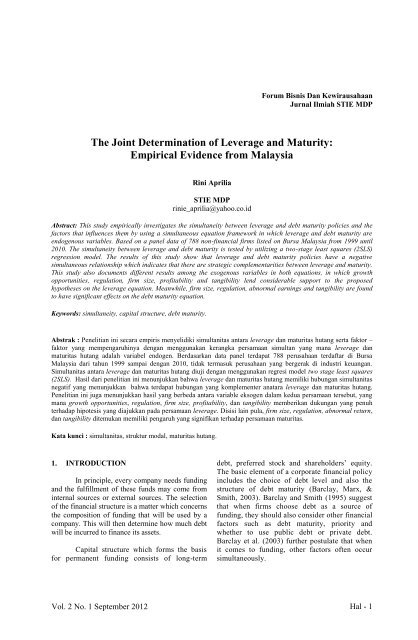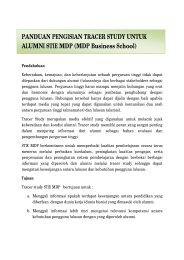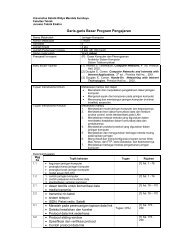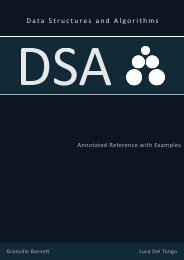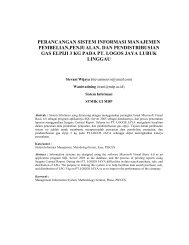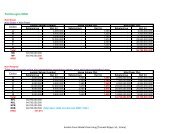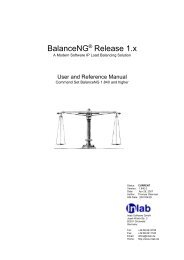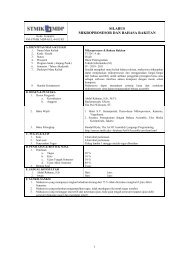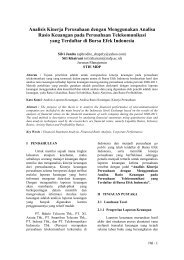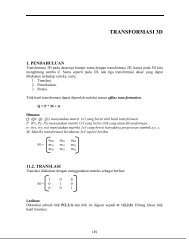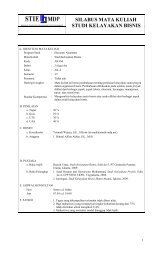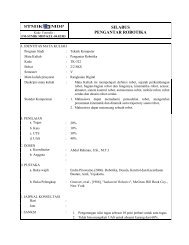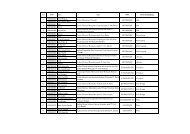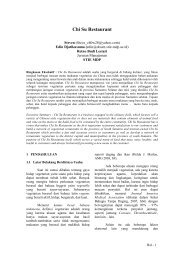The Joint Determination of Leverage and Maturity: Empirical ...
The Joint Determination of Leverage and Maturity: Empirical ...
The Joint Determination of Leverage and Maturity: Empirical ...
- No tags were found...
You also want an ePaper? Increase the reach of your titles
YUMPU automatically turns print PDFs into web optimized ePapers that Google loves.
Forum Bisnis Dan KewirausahaanJurnal Ilmiah STIE MDP<strong>The</strong> <strong>Joint</strong> <strong>Determination</strong> <strong>of</strong> <strong>Leverage</strong> <strong>and</strong> <strong>Maturity</strong>:<strong>Empirical</strong> Evidence from MalaysiaRini ApriliaSTIE MDPrinie_aprilia@yahoo.co.idAbstract: This study empirically investigates the simultaneity between leverage <strong>and</strong> debt maturity policies <strong>and</strong> thefactors that influences them by using a simultaneous equation framework in which leverage <strong>and</strong> debt maturity areendogenous variables. Based on a panel data <strong>of</strong> 788 non-financial firms listed on Bursa Malaysia from 1999 until2010. <strong>The</strong> simultaneity between leverage <strong>and</strong> debt maturity is tested by utilizing a two-stage least squares (2SLS)regression model. <strong>The</strong> results <strong>of</strong> this study show that leverage <strong>and</strong> debt maturity policies have a negativesimultaneous relationship which indicates that there are strategic complementarities between leverage <strong>and</strong> maturity.This study also documents different results among the exogenous variables in both equations, in which growthopportunities, regulation, firm size, pr<strong>of</strong>itability <strong>and</strong> tangibility lend considerable support to the proposedhypotheses on the leverage equation. Meanwhile, firm size, regulation, abnormal earnings <strong>and</strong> tangibility are foundto have significant effects on the debt maturity equation.Keywords: simultaneity, capital structure, debt maturity.Abstrak : Penelitian ini secara empiris menyelidiki simultanitas antara leverage dan maturitas hutang serta faktor –faktor yang mempengaruhinya dengan menggunakan kerangka persamaan simultan yang mana leverage danmaturitas hutang adalah variabel endogen. Berdasarkan data panel terdapat 788 perusahaan terdaftar di BursaMalaysia dari tahun 1999 sampai dengan 2010, tidak termasuk perusahaan yang bergerak di industri keuangan.Simultanitas antara leverage dan maturitas hutang diuji dengan menggunakan regresi model two stage least squares(2SLS). Hasil dari penelitian ini menunjukkan bahwa leverage dan maturitas hutang memiliki hubungan simultanitasnegatif yang menunjukkan bahwa terdapat hubungan yang komplementer anatara leverage dan maturitas hutang.Penelitian ini juga menunjukkan hasil yang berbeda antara variable eksogen dalam kedua persamaan tersebut, yangmana growth opportunities, regulation, firm size, pr<strong>of</strong>itability, dan tangibility memberikan dukungan yang penuhterhadap hipotesis yang diajukkan pada persamaan leverage. Disisi lain pula, firm size, regulation, abnormal return,dan tangibility ditemukan memiliki pengaruh yang signifikan terhadap persamaan maturitas.Kata kunci : simultanitas, struktur modal, maturitas hutang.1. INTRODUCTIONIn principle, every company needs funding<strong>and</strong> the fulfillment <strong>of</strong> these funds may come frominternal sources or external sources. <strong>The</strong> selection<strong>of</strong> the financial structure is a matter which concernsthe composition <strong>of</strong> funding that will be used by acompany. This will then determine how much debtwill be incurred to finance its assets.Capital structure which forms the basisfor permanent funding consists <strong>of</strong> long-termdebt, preferred stock <strong>and</strong> shareholders’ equity.<strong>The</strong> basic element <strong>of</strong> a corporate financial policyincludes the choice <strong>of</strong> debt level <strong>and</strong> also thestructure <strong>of</strong> debt maturity (Barclay, Marx, &Smith, 2003). Barclay <strong>and</strong> Smith (1995) suggestthat when firms choose debt as a source <strong>of</strong>funding, they should also consider other financialfactors such as debt maturity, priority <strong>and</strong>whether to use public debt or private debt.Barclay et al. (2003) further postulate that whenit comes to funding, other factors <strong>of</strong>ten occursimultaneously.Vol. 2 No. 1 September 2012Hal - 1
Forum Bisnis Dan KewirausahaanJurnal Ilmiah STIE MDP<strong>Leverage</strong> <strong>and</strong> debt maturity are the twindimensions that cannot be separated from thecorporate capital structure, in other words, when afirm issues new debt, it needs to decide the period<strong>of</strong> maturity <strong>and</strong> the size <strong>of</strong> the debt levelconcurrently (Elyasiani, Guo, & Tang, 2002). Inaddition, Barclay <strong>and</strong> Smith (1995) assert thatwhen firms choose debt as a source <strong>of</strong> funding,they also need to consider the maturity <strong>of</strong> debtbecause the selection <strong>of</strong> debt maturity will affectthe value <strong>of</strong> the firm. In essence, these studiescontend that the choice <strong>of</strong> debt policy <strong>and</strong> debtmaturity structure should be consideredsimultaneously.Barclay, Marx, <strong>and</strong> Smith (1997) is thepioneering study in examining the simultaneitybetween the policies on leverage <strong>and</strong> debt maturityamong U.S. firms based on a simultaneousequations framework. <strong>The</strong>ir findings revealstrategic complementarities between maturity <strong>and</strong>leverage. Using a different system <strong>of</strong> simultaneousequations, Barclay et al. (2003) show that althoughleverage <strong>and</strong> maturity are strongly correlated interms <strong>of</strong> both unconditional <strong>and</strong> conditionalcorrelations, there is evidence that both leverage<strong>and</strong> debt maturity are not complements. <strong>The</strong>y,however, note that their model is possiblymisspecified. Stohs <strong>and</strong> Mauer (1996) argue thefindings by Barclay <strong>and</strong> Smith (1995) on therelationship between debt maturity <strong>and</strong> growthopportunities are misspecified because they do notcontrol the differences in leverage in their ordinaryleast squares (OLS) debt maturity regression.When Stohs <strong>and</strong> Mauer (1996) add leverage to theright h<strong>and</strong> side <strong>of</strong> their debt maturity regression,they discover that coefficient on the growthopportunities variable has a statistically significantpositive relationship.<strong>The</strong>refore, it is improper to take one aspredeterminant when analyzing how firms choosethe other. <strong>The</strong> coefficients estimated in the OLSregression <strong>of</strong> debt maturity model on the leverage<strong>and</strong> others variables will suffer from simultaneousequation bias (Barclay et al., 2003).Even though, Barclay et al. (2003) find thatthe coefficient on debt maturity in the leverageregression <strong>and</strong> the coefficient on leverage in thedebt maturity regression have a different signwhich indicate that leverage <strong>and</strong> debt maturity arenot complementary to each other, but they believethat leverage <strong>and</strong> debt maturity are stronglycorrelated to each others. Elyasiani et al. (2002)<strong>and</strong> Sunarsih (2004) suggest a positive relationshipbetween leverage <strong>and</strong> maturity, implying leverage<strong>and</strong> maturity are complementary to each other <strong>and</strong>there is simultaneity between leverage <strong>and</strong> debtmaturity policies. Johnson (2003), however, finds anegative relationship between leverage <strong>and</strong> shorttermdebt.Other subsequent empirical studies byElyasiani et al. (2002), Johnson (2003), Sunarsih(2004) <strong>and</strong> Billett, King, <strong>and</strong> Mauer (2007) provideevidences <strong>of</strong> strategic complementarities betweenleverage <strong>and</strong> maturity. Based on these models <strong>of</strong>simultaneous equations framework, this studyattempts to examine the simultaneity between thepolicies on leverage <strong>and</strong> debt maturity amongMalaysian public-listed firms during the periodfrom 1999 to 2010.<strong>The</strong> remaining <strong>of</strong> this study is structured asfollows: the next section presents the reviews <strong>of</strong>theoretical literatures <strong>and</strong> past empirical studies.<strong>The</strong>reafter, the research framework <strong>and</strong> hypothesis,which are constructed from the formulatedresearch, are presented in section three, whilesection four discusses the empirical findings <strong>and</strong>provides the potential explanation <strong>of</strong> the results.Finally last section will concludes the overallresearch with some suggestions for further researchin this field.2. THEORETICAL LITERATURE ANDHYPOTHESIS DEVELOPMENTThis part discusses the relationshipbetween the control variables on leverage <strong>and</strong> debtmaturity. This will enable conclusions to be madeon the influences <strong>of</strong> each variable on the leverage<strong>and</strong> debt maturity. This part also tests thehypothesis formulated for each variable.In this study, Johnson (2003) argues thatthere exists a positive relationship betweenHal - 2 Vol. 2 No. 1 September 2012
Forum Bisnis Dan KewirausahaanJurnal Ilmiah STIE MDPleverage <strong>and</strong> longer term debt maturity. <strong>The</strong>sesimultaneous equation results are consistent withthe single equation model done by Barclay <strong>and</strong>Smith (1995) who find that firms with longermaturity have higher leverage. <strong>The</strong> relationship isalso consistent with Stohs <strong>and</strong> Mauer (1996) <strong>and</strong>Barclay et al. (1997) that find negative relationshipbetween leverage <strong>and</strong> short-term maturity orpositive relationship between leverage <strong>and</strong> longtermmaturity.For others explanatory variables there havebeen a great deal <strong>of</strong> research into both capitalstructure theory <strong>and</strong> debt maturity theory, butrelatively little into how the two theories may relateto each other. In order to lay a theoreticalframework for this study, a review <strong>of</strong> capitalstructure theory <strong>and</strong> debt maturity theory literatureshould be done independently. <strong>The</strong>se studies alsoexplore how <strong>and</strong> why existing researches suggestthat there might be a link between the two proxies.2.1. <strong>The</strong>oretical Literature Under <strong>Leverage</strong><strong>The</strong>oretical researches generally suggestthat leverage is significantly positive to growthopportunities. According to signaling theory, highperforming firms are capable <strong>of</strong> using moreleverage financing since leverage has its deadweight costs, which make less valuable firms morelikely to fall into bankruptcy (Chen, 2004). <strong>The</strong>signaling theory predicts that firms with higherearnings with good growth prospect will use higherleverage.Several studies have been conducted todetermine whether there is a relationship betweenleverage <strong>and</strong> firm size. Titman <strong>and</strong> Wessels (1998),Crutchley <strong>and</strong> Hansen (1989) <strong>and</strong> Rajan <strong>and</strong>Zingales (1995) argue that the possibility <strong>of</strong> a largecompany that went bankrupt is small, so size has apositive effect on the level <strong>of</strong> debt taken.Elyasiani et al. (2002) state that if firmswith NOLs have low tax benefits <strong>of</strong> debt, anegative relationship can be expected betweenNOLs <strong>and</strong> leverage. Firms with higher netoperating loss will have lower leverage to enablethem to manage their debt <strong>and</strong> pay it on time.Generally, leverage is negatively correlated toNOLs dummy. This is a direct implication <strong>of</strong> thetrade-<strong>of</strong>f theory <strong>of</strong> Deangelo <strong>and</strong> Masulis (1980).Capital structure also plays an importantrole in assessing regulation due to the interactionbetween the investment <strong>and</strong> financial decisions <strong>of</strong> aregulated firm <strong>and</strong> also the pricing choices <strong>of</strong>regulators (Spigel&Spulber, 1994). A number <strong>of</strong>studies suggest that rate regulation creates anincentive for regulated firms to increase their level<strong>of</strong> debt <strong>and</strong> there exists a positive relationshipbetween regulated firms <strong>and</strong> leverage.This study also looks at the relationshipbetween the signaling effects <strong>of</strong> debt by using theabnormal earnings as a proxy <strong>of</strong> signaling effect.According to signaling theory, firms with higherreturns always optimize their leverage becausehigher returns always give positive signal to themarket (Flannery, 1986 & Diamond, 1993).Optimism <strong>of</strong> companies about the future will beindicated by an increase in the stock price.According to the pecking order theory,pr<strong>of</strong>itability negatively affects leverage (Myers,1977). This is supported by Megginson (1997) whosuggests the tendency <strong>of</strong> pr<strong>of</strong>itable firms to have aninverse relation with leverage. In other words,firms which are pr<strong>of</strong>itable tend to have smalleramount <strong>of</strong> loans. Furthermore, this is in line withTitman <strong>and</strong> Wessels (1988) <strong>and</strong> Fama <strong>and</strong> French(2002) who find a negative relationship betweenpr<strong>of</strong>itability <strong>and</strong> leverage.<strong>The</strong> literatures on the relationship betweentangibility <strong>and</strong> leverage suggest that tangibility ispositively related to leverage. If a firm has higherasset tangibility, then these assets can be used ascollateral, reducing the risk faced by lender such assuffering from agency cost <strong>of</strong> debt. <strong>The</strong>refore, highleverage is expected to be associated with highfraction <strong>of</strong> tangible assets. In the case <strong>of</strong>bankruptcy, the expected value <strong>of</strong> tangible assetsshould be higher than intangible assets. Harris <strong>and</strong>Raviv (1990) suggest that leverage should increasewith liquidation value <strong>and</strong> this is supported byBarclay et al. (2003). Both <strong>of</strong> them suggest thattangibility is positively related to leverage.Vol. 2 No. 1 September 2012Hal - 3
Forum Bisnis Dan KewirausahaanJurnal Ilmiah STIE MDP2.2. <strong>The</strong>oretical Literature Under Debt <strong>Maturity</strong>In general, firms with higher growthopportunities prefer to use smaller proportion <strong>of</strong>long-term debt whereby they control theirunderinvestment activities <strong>and</strong> agency cost throughshort-term debt (Myers, 1977 &Ozkan, 2002).<strong>The</strong>ir finding was consistent with Arslan <strong>and</strong> Karan(2006) whereby the coefficient was negativelysignificant in their study. <strong>The</strong>y state that firms withgreater growth opportunities prefer to use shortermaturity to solve the underinvestment problem.Lel<strong>and</strong> <strong>and</strong> Th<strong>of</strong>t (1996) show that the optimalcapital structure <strong>of</strong> a firm also depends on debtmaturity <strong>and</strong> it is lower when the firm is financedby short-term debt.Marsh (1982) finds that firms with largersize more <strong>of</strong>ten choose long-term debt maturity,whereas small firms will choose short-term debt.Bevan <strong>and</strong> Danbolt (2000) in their researchdocument a positive effect <strong>of</strong> firm size on debtmaturity. Thus, small firms are expected to use lesslong-term debt than the larger firms. Titman <strong>and</strong>Wessels (1998) state that the possibility <strong>of</strong> largecompanies getting into bankruptcy is small <strong>and</strong>thus, it can positively affect the level <strong>of</strong> debt takenby the companies. Large firms, in general, tend tohave more stable cash flows <strong>and</strong> more diversifiedassets. This means that large companies will uselong-term debt more than small companies do. <strong>The</strong>latter prefer to use short-term debt maturity.Johnson (2003) argues that firms that havegreater net operating loss carryforwards tend to useshort-term debt maturity. It means that there is anegative relationship between NOLs dummy <strong>and</strong>the debt maturity. If firms with NOLs have low taxbenefits <strong>of</strong> debt, the negative coefficient will affectthe debt maturity.Barclay et al. (2003) state that optimal debtmaturity should be longer for regulated firmsbecause regulatory control restrict managers’discretion over corporate investment decisions <strong>and</strong>thereby able to control aspects <strong>of</strong> underinvestmentissues. <strong>The</strong> positive relationship between regulateddummy <strong>and</strong> debt maturity is also supported byBarclay <strong>and</strong> Smith (1995) who argue that regulatedfirms can borrow longer leverage due to lessdiscretion in investment decision, <strong>and</strong> also lessagency problem. Flannery (1986) argues that utilityfirms are expected to issue longer term debtmaturity than other industrial firms.Based on the signaling theory, companieswith higher returns will give positive signal to themarket. Hence, firms with positive informationabout future prospect prefer to use short-term debtthat can be refinanced after information is revealed(Flannery, 1986). According to signaling theory,the selection <strong>of</strong> maturity structure selected bymanagers will provide useful information toinvestors.This study also sees the relationshipbetween asset maturities against debt maturity. Ifthe debt has a maturity that is longer than thematurity <strong>of</strong> its assets, then there is a tendency forcompanies that do not have enough cash to paydebts until it matures. Conversely, if the debt has amaturity shorter than maturity <strong>of</strong> its assets, thencompanies which do not have enough funds willchoose to refinance according to priority. Thisargument is supported by Myers (1977). Thisargument is also in line with Stohs <strong>and</strong> Mauer(1996) who assert that when debt maturity isshorter than asset maturity, the firm may not havesufficient cash to meet its obligations when theyfall due; in other words, when the maturity <strong>of</strong> debtis longer than its asset maturity, the firm will havedebt obligations to meet while cash flows fromasset stop. <strong>The</strong>refore, the following hypothesis istested that asset maturity has positive relationshipwith debt maturity.Table 1: Summary <strong>of</strong> Hypothesis<strong>Leverage</strong> EquationH1aDebt maturity has a positive effect onleverageH2Growth opportunities have a positiveeffect on leverageH3 Firm size has a positive effect on leverageH4 NOL has a negative effect on leverageH5Regulated firm has a positive effect onleverageHal - 4 Vol. 2 No. 1 September 2012
Forum Bisnis Dan KewirausahaanJurnal Ilmiah STIE MDPTable 1: Continued<strong>Leverage</strong> EquationH6Abnormal earnings has a positive effecton leverageH7Pr<strong>of</strong>itability (ROA) has a negative effecton leverageH8Tangibility has a positive effect onleverageDebt <strong>Maturity</strong> EquationH1b<strong>Leverage</strong> has a positive effect on debtmaturityH9Growth opportunities have a negativeeffect on debt maturityH10Firm size has a positive effect on debtmaturityH11NOL has a negative effect on debtmaturityH12Regulated firm has a positive effect ondebt maturityH13Abnormal earnings has a negative effecton debt maturityH14Asset maturity has a positive effect ondebt maturityH15Term structure has a positive effect ondebt maturity(MGS) <strong>and</strong> Treasury-bills (T-bills) are sourcedfrom the Bank Negara Malaysia’s website. <strong>The</strong>population <strong>of</strong> this study consists <strong>of</strong> companieslisted on Bursa Malaysia from 1999 to 2010. <strong>The</strong>total number <strong>of</strong> listed companies is 850 from 12different industrial sectors, namely plantation,property, consumer, construction, trading/services,technology, mining, industrial products, hotels,infrastructure project, finance <strong>and</strong> Real EstateInvestment Trusts (REITs).<strong>The</strong> sample is derived based on apurposive sampling technique. This technique isused to select the sample based on specific criteria<strong>and</strong> certain consideration adjusted to the purpose <strong>of</strong>study. <strong>The</strong> initial sample used in this studycomprises <strong>of</strong> 850 companies listed on BursaMalaysia.Table 2: List <strong>of</strong> Sample DataSource: Based on past related studyAccording to tax hypothesis, the firm’sdebt maturity will increase with the slope <strong>of</strong> theyield <strong>and</strong> they are expected to have a positiverelationship, which are supported by Barclay <strong>and</strong>Smith (1995) <strong>and</strong> Stohs <strong>and</strong> Mauer (1996). Kim etal. (1995) state that the increase in the slope <strong>of</strong>term structure <strong>and</strong> the interest rate volatility canmake firms to choose longer term debt maturity intheir capital structure. Hence, term structure isexpected to have a positive relationship to debtmaturity.3. METHODOLOGY<strong>The</strong> financial data are obtained fromDataStream <strong>and</strong> the industrial classifications arederived from Bursa Malaysia. <strong>The</strong> data for monthendyields <strong>of</strong> Malaysian Government SecuritiesSource: Data stream<strong>The</strong> target sample in this study must meetthe following criteria: first, the companies are nonfinancialfirms listed on Bursa Malaysia; <strong>and</strong>second, the companies must have continuouslypublished their financial reports from 1999 to 2010.A total <strong>of</strong> 51 firms in the financial sector areexcluded because <strong>of</strong> their financial structures arelikely to be influenced by different factors (e.g.capital adequacy regulations) than other nonfinancialfirms. In addition, 21 firms are excludeddue to incomplete data. <strong>The</strong>refore, the final samplesize for this study consists <strong>of</strong> 778 listed firms (seeTable 2).Vol. 2 No. 1 September 2012Hal - 5
Forum Bisnis Dan KewirausahaanJurnal Ilmiah STIE MDP3.1. Analytical TechniquesThis technique is used to test thesimultaneity between leverage <strong>and</strong> debt maturity asthe dependent variables in order to determine therelationship <strong>of</strong> the two policies <strong>and</strong> the independentvariables such as growth opportunities, regulatedfirm, firm size, NOL carryforwards, abnormalearnings, pr<strong>of</strong>itability, tangibility, asset maturity,<strong>and</strong> term structure that affect leverage <strong>and</strong> debtmaturity. <strong>The</strong> basic model <strong>of</strong> leverage <strong>and</strong> debtmaturity equation is formulated as follows:Where:3.2 VariablesBased on the research problems <strong>and</strong>development <strong>of</strong> hypotheses, the variables that areexamined in this study <strong>and</strong> their measurement arelargely adopted from existing literature. <strong>The</strong>dependent variables are leverage <strong>and</strong> debt maturity;the explanatory variables include growthopportunity, regulated firms, firm size, NOLs,abnormal earnings, pr<strong>of</strong>itability, tangibility, assetmaturity <strong>and</strong> term structure. <strong>The</strong> definition <strong>of</strong> thesevariables is listed in table 4.Table 4: Measurement <strong>of</strong> VariablesVariablesDependent Variables<strong>Leverage</strong>MeasurementRatio <strong>of</strong> book value <strong>of</strong> total debtVariablesDebt<strong>Maturity</strong>Independent VariablesGrowthRegulatedFirmsFirm SizeNetOperatingLossAbnormalEarningsPr<strong>of</strong>itabilityTangibilityAsset<strong>Maturity</strong>TermStructureMeasurementto total assetRatio <strong>of</strong> long term debt to totaldebtGROW is total asset plus marketcapitalization then minuscommon equity, divided by totalasset.<strong>The</strong> measurement <strong>of</strong> regulatedfirms are using dummy variable,1 for utilities companies <strong>and</strong>others are 0.Measured by using the naturallogarithm <strong>of</strong> total assets <strong>of</strong> eachcompanyNOL carryforwards dummyequals one form firms with netoperating loss carry forwards <strong>and</strong>zero otherwise<strong>The</strong> difference between earningsin year t+1 <strong>and</strong> t, then divided byearnings in year t.Ratio <strong>of</strong> EBITDA to total assets.Ratio <strong>of</strong> tangible asset divides bytotal assets.Ratio <strong>of</strong> fixed assets to annualdepreciation expenses<strong>The</strong> difference between themonth end yields on long term10-year government bonds(MGS) <strong>and</strong> matched with thefirm’s fiscal year end.Source: Secondary data that has been processed20124. RESULTS AND DISCUSSION4.1. Summary Statistics <strong>and</strong> Correlation Matrix<strong>of</strong> VariablesTable 5 reports the descriptive statistics forthe entire sample which are used for the singleequation <strong>and</strong> also simultaneous equations regressionanalysis. <strong>The</strong> data was analyzed by using Eviews 7,covering a total <strong>of</strong> 5721 observations.Hal - 6 Vol. 2 No. 1 September 2012
Forum Bisnis Dan KewirausahaanJurnal Ilmiah STIE MDPMean (Median) leverage is 0.26 (0.24), itmeans that on average, Malaysian firms only use26.00% as leverage to finance their project. <strong>The</strong>mean for debt maturity is 0.39 which means that onaverage, the long term debt represent 39% <strong>of</strong> thetotal debt incurred by Malaysian firms. For growthopportunities, the mean is about 1.07, whichsignifies that investment opportunity is high inMalaysia. It is in line with a study conducted byJensen (1986) which finds that firms with higherinvestment opportunity usually have high growth,active in investment, lower free cash flow <strong>and</strong>lower asset in place.<strong>The</strong> mean <strong>of</strong> regulated firm is 0.03 withst<strong>and</strong>ard deviation about 0.17 which signals thatthe distribution <strong>of</strong> data is not normal. This alsomeans that the utility firms or other regulated firmsin Malaysia is relatively fewer in number than nonregulatedfirms. <strong>The</strong> abnormal earnings variableswhich are tested to see the signaling effect have anaverage figure <strong>of</strong> about 0.11 with the minimumvalue at -369.03 <strong>and</strong> the maximum value at110.96. This data shows abnormal distribution<strong>and</strong> can produce biased result as well.Meanwhile, the mean figure <strong>of</strong> ROA st<strong>and</strong>s at3.94 with a st<strong>and</strong>ard deviation <strong>of</strong> 14.04,indicating that the firms are highlypr<strong>of</strong>itable. <strong>The</strong>average tangibility figure is 0.41 with a st<strong>and</strong>arddeviation <strong>of</strong> 0.21; this means that the data isnormally distributed.In addition, the means <strong>of</strong> asset maturity<strong>and</strong> term structure among Malaysian firms st<strong>and</strong>at 36.40 <strong>and</strong> 1.5 respectively. <strong>The</strong> high figure <strong>of</strong>asset maturity indicates that most Malaysianfirms have lower depreciation on assets whichimplies that the firms have the ability to issuelong-term debt maturity. Furthermore, thest<strong>and</strong>ard deviation <strong>of</strong> term structure is less thanits average <strong>of</strong> about 0.93; it denotes that thelower the st<strong>and</strong>ard deviation from its average,the better the result will be since the data isnormally distributed.Table 5: Descriptive Statistics for Entire SampleMean Median Max Min Std. Dev. ObsLev 0.2640 0.2357 10.273 0.0000 0.2872 5721DM 0.3890 0.3453 1.0000 0.0000 0.3130 5721GROW 1.0666 0.9090 19.101 0.2372 0.7579 5721SIZE 12.779 12.565 18.451 7.7098 1.3385 5721NOL 0.2381 0.0000 1.0000 0.0000 0.4259 5721REGUL 0.0295 0.0000 1.0000 0.0000 0.1693 5721ABNR 0.1134 0.0269 110.96 -369.037 5.5641 5721ROA 3.9408 4.0800 771.45 -93.4700 14.038 5721TANG 0.4063 0.3976 0.9875 0.0000 0.2069 5721ASMAT 36.406 13.356 3352.4 -2142.26 112.99 5721SPRED 1.5143 1.2940 4.0550 0.0390 0.9313 5721Source: Secondary data that has been processed 2012Note: <strong>The</strong> number <strong>of</strong> observations is 5806 inEquation 1 <strong>and</strong> 6024 in Equation 2 consisting <strong>of</strong> thesample <strong>of</strong> listed companies during the 1999-2010periods. LEV is generated by dividing total debt tototal asset. DM is long term debt divided by totaldebt. GROW is total asset plus market capitalizationthen minus common equity, divided by total asset.REGUL used a dummy variable, 1 for utilitiescompanies <strong>and</strong> other are 0. SIZE is measured by log<strong>of</strong> total assets. NOL carryforwards dummy equalsto1 for net operating loss <strong>and</strong> 0 otherwise. ABNR isthe difference between earnings in year t+1 <strong>and</strong> t,Vol. 2 No. 1 September 2012Hal - 7
Forum Bisnis Dan KewirausahaanJurnal Ilmiah STIE MDPthen divided by earnings in year t. PROFIT is theratio <strong>of</strong> EBITDA to total assets. TANG istangible asset divide by total assets. ASMAT isthe ratio <strong>of</strong> fixed assets to annual depreciationexpenses. SPREAD is measured by thedifference between the month-end yields on longterm 10-year government bonds (MGS) <strong>and</strong>three-month Treasury-bills <strong>and</strong> matched with thefirm’s fiscal year-end.Table 6 <strong>and</strong> 7 presents the correlationmatrix among the variables in the leverageequation <strong>and</strong> debt maturity equation,respectively. <strong>The</strong>se correlations express somesimple relations among the variables beforegenerating the simultaneous equations regressionresults. It can be seen in both tables that leverage<strong>and</strong> debt maturity are positively correlated <strong>and</strong>significant at 1% level.Table 6: Correlation Matrix for <strong>Leverage</strong>LEV DM GROW SIZE NOL REGUL ABNR ROA TANGLEV 1-----DM 0.0392*** 1(2.9920) -----GROW 0.3562*** 0.0452*** 1(29.0404) (3.4485) -----SIZE 0.0261** 0.3614*** -0.0154 1(1.9887) (29.5287) (-1.17) -----NOL 0.1814*** -0.0673*** -0.0047 -0.1652*** 1(14.0491) (-5.1364) (-0.3568) (-12.7585) -----REGUL 0.0388*** 0.203618*** 0.0393*** 0.2900*** -0.0421 1(2.957) (15.8444) (2.9993) (23.0870) (-3.2101) -----ABNR 0.1165*** -0.0029 0.0787*** -0.0096 0.0127 0.0034 1(8.9371) (-0.2175) (6.0153) (-0.7295) (0.9705) (0.2613) -----ROA -0.2021*** 0.0609*** 0.1329*** 0.0813*** -0.2064*** 0.0252* -0.0083 1(-15.7248) (4.6457) (10.2131) (6.2147) (-16.0712) (1.9198) (-0.6301) -----TANG 0.0607*** 0.1812*** -0.0743*** 0.0693*** 0.004 0.0325** 0.006 -0.0565*** 1(4.6301) (14.0353) (-5.6761) (5.2890) (0.3052) (2.4806) (0.4580) (-4.3094) -----Source: Secondary data that has been processed 2012Note: <strong>The</strong> number <strong>of</strong> observations is 5275 consisting<strong>of</strong> the sample <strong>of</strong> listed companies during the 1999-2010 period. LEV is generated by dividing total debtto total asset. DM is long-term debt divided by totaldebt. GROW is total asset plus market capitalizationthen minus common equity, divided by total asset.REGUL used dummy variable, 1 for utilitiescompanies <strong>and</strong> other are 0. SIZE is measured by log<strong>of</strong> total assets. NOL carryforwards dummy equals 1for net operating loss <strong>and</strong> 0 otherwise. ABNR is thedifference between earnings in year t+1 <strong>and</strong> t, thendivided by earnings in year t. PROFIT is the ratio <strong>of</strong>EBITDA to total assets. TANG is tangible assetdivided by total assets.Hal - 8 Vol. 2 No. 1 September 2012
Forum Bisnis Dan KewirausahaanJurnal Ilmiah STIE MDPTable 7: Correlation Matrix for Debt <strong>Maturity</strong>DM LEV GROW SIZE NOL REGUL ABNR ASMAT SPEARDDM 1-----LEV 0.0404*** 1(3.1405) -----GROW 0.0392*** 0.3410*** 1(3.0437) (28.1456) -----SIZE 0.3652*** 0.0323** -0.0280** 1(30.439) (2.5043) (-2.1732) -----NOL -0.0524*** 0.1804*** -0.0122 -0.1401*** 1(-4.0683) (14.2349) (-0.9484) (-10.9827) -----REGUL 0.2051*** 0.0411*** 0.0348*** 0.2931*** -0.0396** 1(16.2583) (3.1921) -2.7045 -23.7877 (-3.0777) -----ABNR 0.0089 0.1093*** 0.0672*** -0.0015 0.0065 0.0017 1(0.6889) (8.5297) -5.223 (-0.1213) (0.5063) -0.1326 -----ASMAT 0.1275*** -0.0119 -0.0693*** 0.0880*** 0.0429*** -0.0281** 0.2532*** 1(9.9765) (-0.9253) (-5.3889) (6.8545) (3.3353) (-2.1812) -20.3117 -----SPREAD -0.0328** -0.0004 0.0670*** 0.0006 -0.013 0.005 -0.0152 -0.0198 1(-2.5477) (-0.0305) (5.2147) (0.0446) (-1.0097) -0.3845 (-1.1759) (-1.5354) -----Source: Secondary data that has been processed 2012Note: <strong>The</strong> number <strong>of</strong> observations is 5275 consisting<strong>of</strong> the sample <strong>of</strong> listed companies during the 1999-2010 period. LEV is generated by dividing total debtto total asset. DM is long-term debt divided by totaldebt. GROW is total asset plus market capitalizationthen minus common equity, divided by total asset.REGUL used dummy variable, 1 for utilitiescompanies <strong>and</strong> other are 0. SIZE is measured by log<strong>of</strong> total assets. NOL carryforwards dummy equals 1for net operating loss <strong>and</strong> 0 otherwise. ABNR is thedifference between earnings in year t+1 <strong>and</strong> t, thendivided by earnings in year t. ASMAT is the ratio <strong>of</strong>fixed assets to annual depreciation expenses.SPREAD is measured by the difference between themonth-end yields on long term <strong>of</strong> 10-yearsgovernment bonds (MGS) <strong>and</strong> three-monthTreasury-bills <strong>and</strong> matched with the firm’s fiscal year.In addition, all variables are significantlycorrelated to the leverage at 1%level except for theasset maturity <strong>and</strong> term structure. Only ROA is foundto have a significant negative relationship withleverage. Debt maturity is positively <strong>and</strong> statisticallysignificant to the growth opportunities, size, regulatedfirm, ROA, tangibility <strong>and</strong> asset maturity at 1% level.However, theNOL carrryforwards is negative <strong>and</strong>significant to debt maturity at 1% level <strong>and</strong> termstructure is also negatively significant to the debtmaturity at 5% level.In this study also do some test like VarianceInflation Factor (VIF) that is used to detect theexistence <strong>of</strong> the symptoms <strong>of</strong> multicollinearitybetween the explanatory variable. <strong>The</strong> resultshows that there are no independent variablesVol. 2 No. 1 September 2012Hal - 9
Forum Bisnis Dan KewirausahaanJurnal Ilmiah STIE MDPthat have VIF values greater than 10. <strong>The</strong>refore,it is concluded that there is no multicollinearitybetween independent variables in bothregression models.4.2. Regression AnalysisThis study investigates empirically therelationship between leverage <strong>and</strong> debt maturityby using a simultaneous equations model on debtmaturity <strong>and</strong> leverage for all sample panel data.This study also estimates a single equationwithout endogeneity <strong>and</strong> with endogeneity forboth leverage <strong>and</strong> debt maturity using pooledEGLS with AR(1) to compare with previousstudies. Estimation using EGLS will potentiallyreduce the number <strong>of</strong> observation since it is ableto determine <strong>and</strong> adjust the data to be used. EGLSis also able to overcome the problem onheteroscedasticity <strong>and</strong> autocorrelation as evidentfrom the Durbin-Watson analysis equals to 1.91for leverage <strong>and</strong> 2.12 for debt maturity.<strong>The</strong> results <strong>of</strong> all regression analysis inTable 8 report that growth opportunity issignificantly positive in all regression both insingle <strong>and</strong> simultaneous equation to the leverage.It means that Malaysian firms which have highgrowth opportunity will take much moreleverage in the determination <strong>of</strong> capital structure.However, the growth opportunity does not affectthe determination <strong>of</strong> debt maturity. Thus,Malaysian firms cannot rely on growthopportunity in determining debt maturity. Insum, there is a relationship between leverage <strong>and</strong>growth opportunity as predicted, while on theother h<strong>and</strong>, growth opportunity does notsignificantly affect debt maturity <strong>and</strong> thus, theproposed hypothesis is rejected.Regulated firm <strong>and</strong> firm size arestatistically significant in both hypothesis <strong>of</strong>leverage <strong>and</strong> debt maturity either in single <strong>and</strong>simultaneous regression. This is in line with astudy conducted by Barclay et al. (2003) <strong>and</strong>Johnson (2003). <strong>The</strong> positive relationship thatexists between regulated firm <strong>and</strong> leverages isbecause regulated firms always maintain optimalleverage to reduce the agency risk (Bradley, Jarrell<strong>and</strong> Kim., 1984). While for maturity regression,positive coefficient at 1% level <strong>of</strong> significantwhich is in accordance to Barclay <strong>and</strong> Smith(1995) who state that regulated firm can borrowlonger term debt due to less discretion ininvestment decision, <strong>and</strong> also less agencyproblems.Furthermore, firm size is also positivelysignificant in both regressions in accordancewith the findings by Bevan <strong>and</strong> Danbolt (2002)<strong>and</strong> Barclay et al. (2003). All empirical studiessuggest positive relation between firm sizes toleverage due to the fact that larger firms havesmaller probability <strong>of</strong> facing bankruptcy thusallowing them to take higher leverage whichalso means having easy access to the bondmarket (Titman <strong>and</strong> Wessels, 1998) <strong>and</strong> (Rajan<strong>and</strong> Zingales, 1995). Meanwhile, therelationship between debt maturity <strong>and</strong> firm sizeis positively significant. Positive effect <strong>of</strong> firmsize, in accordance with the proposedhypothesis, <strong>and</strong> the results support the studyconducted by Titman <strong>and</strong> Wessels (1998),Bevan <strong>and</strong> Danbolt (2000) <strong>and</strong> Barclay <strong>and</strong>Smith (1995).While, for net operation losscarryforwards variable is positively significant toleverage but only significant in single equations.<strong>The</strong> positively significant relationship betweennet operating loss carryforwards <strong>and</strong> leveragecontradicts with the predicted sign which is inline with studies by Barclay, Marx <strong>and</strong> Smith(1997) <strong>and</strong> Harris <strong>and</strong> Raviv (1991). It indicatesthat firms in Malaysia with higher net operatingloss carryforwards will have higher leverage dueto the losses generated by the net operating losscarryforwards which cause equity to fall invalue.Abnormal earnings have significant affect<strong>and</strong> the hypothesis is accepted but it contradictswith the predicted sign. In this study, negativerelationship between abnormal earnings <strong>and</strong>leverage is supported by Muradoglu <strong>and</strong>Sivaprasad (2009). Thus, for Malaysian firms withhigher abnormal earnings, they will use lowerleverage, however the study by.Hal - 10 Vol. 2 No. 1 September 2012
Forum Bisnis Dan KewirausahaanJurnal Ilmiah STIE MDPTable 8 : Three Different Estimators <strong>of</strong> LEV <strong>and</strong> DM EquationSource: Secondary data that has been processed 2012St<strong>and</strong>ard errors in parentheses are for coefficient <strong>and</strong> P values for diagnostic test. ***,**,* Statisticallysignificant at the 1%, 5%, <strong>and</strong> 10% level, respectively (two-tailed test)Modigliani <strong>and</strong> Miller (1958) findpositively significant relationship only for utilitiessectors. <strong>The</strong>refore, it is possible for industry inMalaysia to have negative relationship betweenabnormal earnings <strong>and</strong> leverage.On the other h<strong>and</strong>, debt maturity equationaccepted the proposed hypothesis, which is in linewith study conducted by Barclay <strong>and</strong> Smith (1995)<strong>and</strong> Sunarsih (2004) that argue abnormal earningsgive good signal to the market which means thatthe firm is <strong>of</strong> good quality; more valuable firm willuse more short term debt than long term debt.As expected, pr<strong>of</strong>itability <strong>and</strong> tangibilityare consistent <strong>and</strong> thus support the proposedhypothesis in leverage equation either in single orsimultaneity regression. This is also in line withasset maturity which is consistent to proposedhypothesis <strong>and</strong> positively significant to debtmaturity equation. Thus, Malaysian firms can takethese three variables namely, pr<strong>of</strong>itability,tangibility <strong>and</strong> asset maturity into considerationsin determining the level <strong>of</strong> debt in capitalstructure.In addition, the result <strong>of</strong> term structurerejects the hypothesis in all regression, either in asingle <strong>and</strong> simultaneous regression. <strong>The</strong>refore,term structure cannot be used by Malaysian firmsas a reference in determining the level <strong>of</strong> debtespecially in debt maturity.Lastly, for the simultaneity test, thisstudy found that negative <strong>and</strong> statisticallysignificant between leverage <strong>and</strong> debt maturitywhich is not in accordance with predictedsign.This may be due to leverage <strong>and</strong> maturityVol. 2 No. 1 September 2012Hal - 11
Forum Bisnis Dan KewirausahaanJurnal Ilmiah STIE MDPare substitutes in addressing the under <strong>and</strong> overinvestment problems (Barclay et al., 2003).Other explanations regarding discrepancybetween the predicted sign <strong>and</strong> the result may alsobe due to the definition <strong>of</strong> long term debt adoptedin this study in which it has no clear st<strong>and</strong>ard.According to Barclay et al. (2003), they state thatmeasurements for debt maturity equal to thefraction <strong>of</strong> the firm’s total debt measured for morethan 3 years. Whereas in this study, long term debtis a variable collected from Datastream with theterms <strong>of</strong> debt that have maturity <strong>of</strong> more than oneyear; this proportion is similar to short term debt byJohnson (2003), in which the proportion <strong>of</strong> debtmatures within three years. Thus, it can bepossible, that the long-term debt in this studycomes under the category <strong>of</strong> short-term debt asused by Johnson (2003).In Malaysia, most companies are usingshort-term debt maturity than long- term debt <strong>and</strong>only a few companies issue Sukuk (Mustapha,Ismail, &Minai, 2011). This also confirms thefinding by Demirguc-Kunt <strong>and</strong> Maksimovic (1999)that the most fundamental difference betweendeveloped <strong>and</strong> developing countries is thatdeveloping countries would prefer to use short termdebt rather than using long term debt. So, note thatthere is possibility that the long term debt in thisstudy is actually included in the category <strong>of</strong> shortterm debt as it stated by Johnson (2003).simultaneous equations framework in whichleverage <strong>and</strong> debt maturity are endogenous. Basedon the analysis <strong>of</strong> the results <strong>and</strong> discussion thathave been described in the previous section, it canbe concluded that results <strong>of</strong> this study indicate thepresence <strong>of</strong> simultaneity between leverage <strong>and</strong> debtmaturity with negative coefficient <strong>and</strong> significantlyproven. This is shown by the negative sign on thevariable leverage <strong>and</strong> debt maturity in bothleverage <strong>and</strong> debt maturity equation. This showsthat the relationship between leverage <strong>and</strong> debtmaturity are complementary, which means there isa negative direction <strong>of</strong> the simultaneity relationshipbetween the two equations. Thus, the coefficientestimated in an OLS regression <strong>of</strong> single equationswill suffer from simultaneous equation bias.In addition, this study does not includesome exogenous variables used in the past studies,which are considered to have significant effects onthe two policies. <strong>The</strong>re are several variables thataffect the leverage <strong>and</strong> debt maturity variables. As arecommendation for further research, adding somevariables such as non-debt tax shield, dividend yield<strong>and</strong> covenants, could potentially increase theaccuracy in analyzing the relationship <strong>of</strong>simultaneity between leverage <strong>and</strong> debt maturity.APPENDIX ATable 9: Hypotheses Testing SummaryOn the basis <strong>of</strong> the above explanation, it ispossible that the negative results obtained from thisstudy are based on the factors that have beendescribed. It is likely that this study supports thefinding in Johnson (2003). Thus, the negativecoefficient between debt maturity <strong>and</strong> leverage isconsistent with Johnson (2003) in which higherleverage firms use lower short term debt to mitigateinvestment opportunity problems.5. CONCLUSION AND SUGGESTIONSThis study investigates empirically therelationship <strong>of</strong> simultaneity between leverage <strong>and</strong>debt maturity <strong>and</strong> factors that influence it, using aHal - 12 Vol. 2 No. 1 September 2012
Forum Bisnis Dan KewirausahaanJurnal Ilmiah STIE MDPTable 9: ContinuedTable 10 : Multicollinearity Test <strong>of</strong> <strong>Leverage</strong>EquationSource: Secondary data that has been processed2012Source: Secondary data that has been processed 2012Table 11: Multicollinearity Test <strong>of</strong> Debt <strong>Maturity</strong> EquationSource: Secondary data that has been processed 2012Vol. 2 No. 1 September 2012Hal - 13
Forum Bisnis Dan KewirausahaanJurnal Ilmiah STIE MDPTable 12: Summaries <strong>of</strong> Prior StudiesAuthors/ Proxy <strong>Leverage</strong> Debt maturitySimultaneity between Variablesleverage <strong>and</strong> debt maturity usedA B C D E F G H I J K L M N O<strong>Leverage</strong> Debt <strong>Maturity</strong> M/B Regulation Firm Size Pr<strong>of</strong>itability (ROA) Tangibility Effective Tax Rate NOL Dummy Volatility NDTS Abnormal Earning Asset <strong>Maturity</strong> Commercial Paper Dummy Term Structure Liquidity Risk Source: Secondary data that has been processed 2012Note: This table shows the author <strong>of</strong> the previousresearch drawn at r<strong>and</strong>omly in this study. <strong>The</strong>yconsist <strong>of</strong>: A. Rajan <strong>and</strong> Zingales. (1995), B =Titman, S., Wessels, R. (1998), C = Ozkan, A.(2002), D = Chen, J.J (2003), E = Jong, A.de.(2008), F = Barclay <strong>and</strong> Smith. (1995), G = Stohs<strong>and</strong> Mauer (1996), H = Guedes, J. <strong>and</strong> Opler, T.(1996), I = Jhonson, S.A. (1997), J = Stephen, A etal., (2011), K = Elyasiani, E et al., (2002), L =Barclay, M.J., et al., (2003), M = Johnson, S.A.(2003), N = Sunarsih. (2004), O = Fan, J., Titman,S., Twite, G. (2006).REFERENCES[1] Arslan, O., & Karan, M.B 2006, “Ownership<strong>and</strong> Control Structure as Determinants <strong>of</strong>Corporate Debt <strong>Maturity</strong>: a panel study <strong>of</strong> anemerging market”, Journal <strong>of</strong> CorporateGovernance, Vol. 14, p.312- 324.[2] Bank Negara Malaysia, Quarterly Bulletins &Annual Report, Kuala Lumpur, various issues.[3] Barclay, M. J., Marx, L. M., & Smith, C.W.1997, <strong>Leverage</strong> <strong>and</strong> maturity as strategiccomplements, working paper, University <strong>of</strong>Rochester.[4] Barclay, M.J., Marx, L.M., & Smith, C.W.2003, “<strong>The</strong> joint determination <strong>of</strong> leverage<strong>and</strong> maturity”, Journal <strong>of</strong> Corporate Finance,Vol. 9, p. 149-147.[5] Barclay, M.J., & Smith, C.W. 1995, “<strong>The</strong>maturity structure <strong>of</strong> corporate debt.”, Journal<strong>of</strong> Finance, Vol. 50,p. 609-631.[6] Barclay, M.J., Smith, C.W., & Watts, R.L.1995, “<strong>The</strong> determinants <strong>of</strong> corporate leverage<strong>and</strong> dividend policies”, Journal <strong>of</strong> AppliedCorporate Finance, Vol. 7, p. 4-19.Hal - 14 Vol. 2 No. 1 September 2012
Forum Bisnis Dan KewirausahaanJurnal Ilmiah STIE MDP[7] Bevan, A.A., &Danbolt, J. 2000, “ Capitalstructure <strong>and</strong> its determinants in the UnitedKingdom: a decompositional analysis”,Working Paper University <strong>of</strong> Glasgow.[8] Billet, M.T., King. T-H.,&Mauer, D.C. 2007,“Growth opportunities <strong>and</strong> the choice <strong>of</strong>leverage, debt maturity, <strong>and</strong> Covenants”,Journal <strong>of</strong> Finance, Vol. 62(2), p. 627-729.[9] Bradley, M., Jarrell, G.A., & Kim, E.H. 1984,“On the existence <strong>of</strong> an optimal capitalstructure: <strong>The</strong>ory <strong>and</strong> evidence”, Journal <strong>of</strong>Finance, Vol. 39, p. 857-878.[10] Chen, J.J. 2004, “Determinants <strong>of</strong> capitalstructure <strong>of</strong> Chinese listed companies”, Journal<strong>of</strong> Business Research, Vol. 57, p. 1341-1351.[11] Crutchley Claire <strong>and</strong> Robert Hansen 1989, “ATest <strong>of</strong> the Agency <strong>The</strong>ory <strong>of</strong> ManagerialOwnership, Corporate <strong>Leverage</strong>, <strong>and</strong>Corporate Dividends”, FinancialManagement, Vol.18 Winter 1989, p.36-46.[12] DeAngelo, H., <strong>and</strong> R.W. Masulis 1980,“Optimal Capital Structure under Corporate<strong>and</strong> Personal Taxation”, Journal <strong>of</strong> FinancialEconomics Vol. 8, p. 3-29.[13] Demirguc-Kunt, A., &Maksimovic, V. 1999,“Institutions, financial markets <strong>and</strong> firm debtmaturity”, Journal <strong>of</strong> Financial Economics,Vol. 54, p. 295-336.[14] Diamond, D.W. 1993, “Seniority <strong>and</strong> maturity<strong>of</strong> debt contracts”, Journal <strong>of</strong> FinancialEconomics, Vol. 33, p. 341-68.[15] Elyasiani. E., Guo, L., & Tang, L. (2002). <strong>The</strong>determinants <strong>of</strong> debt maturity at issuance: Asystem-based model. Review <strong>of</strong> QuantitativeFinance <strong>and</strong> Accounting, Vol. 19, p. 351-377.[16] Flannery, M. J. 1986, “Asymmetricinformation <strong>and</strong> risky debt maturity choice”,Journal <strong>of</strong> Finance, Vol. 41, p. 19-37.[17] Fama, E. F. dan K. R. French 2002, “TestingTrade-Off <strong>and</strong> Pecking Order Predictionsabout Dividends <strong>and</strong> Debt”, Review <strong>of</strong>Financial Studies, Vol. 15, p. 1-33.[18] Harris, M., &Raviv, A. 1991, “<strong>The</strong> theory <strong>of</strong>capital structure”, Journal <strong>of</strong> Finance, Vol. 46,p. 297-355.[19] Johnson, S. A. 2003, “Debt maturity <strong>and</strong> theeffects <strong>of</strong> growth opportunities <strong>and</strong> liquidityrisk on leverage”, Review <strong>of</strong> Financial Studies,Vol. 16(1), p. 209-236.[20] Lel<strong>and</strong>, H.E., &T<strong>of</strong>t, K.B. 1996,“Optimalcapital structure, endogenousbankruptcy, <strong>and</strong> the term structure <strong>of</strong> creditspreads”, Journal <strong>of</strong> Finance,Vol. 51, p. 987–1019.[21] Marsh, P. 1982, “<strong>The</strong> choice between equity<strong>and</strong> debt: An empirical study”, Journal <strong>of</strong>Finance, Vol. 45, p. 1471–1493.[22] Megginson, W.L. 1997, “Corporate Finance<strong>The</strong>ory”. Addison Wesley EducationalPublishers.[23] Modiglini, F., & Miller, M.H. 1995, “<strong>The</strong> cost<strong>of</strong> capital, corporate finance <strong>and</strong> the theory <strong>of</strong>investment”, American Economic Review,Vol. 48, p. 201-97.[24] Myers, S.C. 1977, “Determinants <strong>of</strong> corporateborrowing”. Journal <strong>of</strong> Financial Economics,Vol. 5, p. 147–175.[25] Muradoglu, G. Y., <strong>and</strong> Sivaprasad, S. 2009,“Using firm level leverage as an investmentstrategy”, SSRN Working Paper Series.[26] Mustapha, M., Ismail, H., &Minai, B. 2011,“Determinants <strong>of</strong> debt structure: <strong>Empirical</strong>evidence from Malaysia”, 2 nd InternationalConference on Business <strong>and</strong> EconomicResearch Proceeding.[27] Ozkan, A. 2002, “<strong>The</strong> determinants <strong>of</strong>corporate debt maturity: evidence from UKFirms”, Applied Financial Economics, Vol. 12(1), p. 19-24.Vol. 2 No. 1 September 2012Hal - 15
Forum Bisnis Dan KewirausahaanJurnal Ilmiah STIE MDP[28] Rajan, R.G., &Zingales, L. 1995, “What dowe know about capital structure? someevidence from international data”, <strong>The</strong> Journal<strong>of</strong> Finance, Vol. 50(5), p. 1421 – 1460.[29] Spiegel, Yossef.,& Daniel F. Spulber, 1994,“<strong>The</strong> capital structure <strong>of</strong> a regulated firm”,R<strong>and</strong> Journal <strong>of</strong> Economics, Vol. 25, p. 424-440[30] Sunarsih 2004, “Analisissimultanitaskebijakan hutang dan kebijakan maturitashutang serta faktor-faktor yangmempengaruhinya”, JurnalSiasatBisnis, Vol.9(1), p. 65-84.[31] Stohs, M. H., & Mauer, D. C. 1996, “<strong>The</strong>determinants <strong>of</strong> corporate debt maturitystructure”, Journal <strong>of</strong> Business, Vol. 69, p.279- 312.[32] Titman, S., &Wessels, R. 1988, “<strong>The</strong>determinants <strong>of</strong> capital structure choice”,Journal <strong>of</strong> Finance, Vol. 43, p. 1–19.Hal - 16 Vol. 2 No. 1 September 2012


